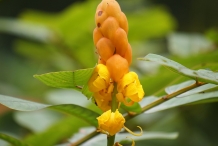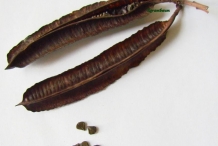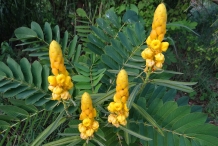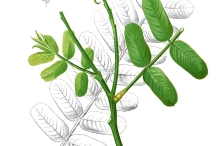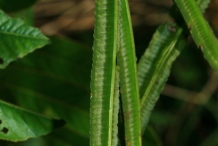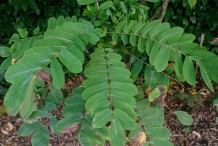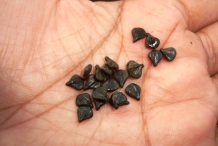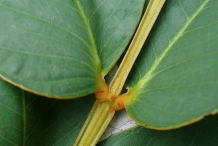Its common names are Candelabra Bush, Candle Bush, Candelabra Plant, Candlestick Senna, Emperor’s Candlesticks, Empress-Candleplant, Christmas-Candle, Emperor’s Candlesticks, Emperor’s Candle Plant, Golden-Candle Senna, King-of-the-Forest, Golden Candelabra Tree, Ringworm Bush, Ringworm Senna, Ringworm Plant, Ringworm Bush, Ringworm Shrub, Seven Golden Candles, Roman Candle Tree, Seven- Golden-Candlesticks, Winged Senna, Stick Senna and Yellowtop, Ringworm tree.
Plant
It is an erect, coarse and branched shrub that grows 1.5 to 4 meters tall. The plant has alternate, pinnate leaves measuring 50 to 80 cm with 8 to 14 pairs of large leaflets. Leaflets are ovate to oblong, truncate, obtuse and is upto 17 cm. Inflorescence is erect, dense, long pendunculate, axillary or terminal measuring 10 to 15 cm long with crowded and overlapping yellow flowers. Flowers are 4 cm in diameter and are enclosed within dark-yellow or orangey bracts that shed off during flower opening. The bisexual flowers have 5 bright yellow ovate to orbicular petals and 5 oblong sepals with 10 stamens, 2 fertile and elongated anthers. Flowers give way to green pods that ripens brown to black. Pods are straight, winged, papery in texture measuring 15 to 20 cm long and over 1 cm wide. Each pod contains shiny, flat and triangular seeds.
Stems and Leaves
Stems are upright and occasionally branched. Leaves are alternately arranged along stems and are very large. They are borne on stalks about 2 to 4 cm long and have 8 to 14 pairs of large leaflets. Each leaflet is oblong, oval or egg shaped in outline measuring 5 to 7 cm long and 2 to 5.5 cm wide. It is finely hairy and have rounded or slightly notched tips.
Flowers and Fruit
Flowers are orange or golden yellow that form in elongated clusters about 15 to 60 cm long at the tips of the stem or in upper leaf forks. The clusters form on hairy stalks measuring 15 to 30 cm long and possess numerous densely crowded flowers. Each flower measures 2 to 3 cm across forming on short stalks of 5 to 8 mm long. Each flower composes of five sepals (about 9 to 15 mm long and 8 mm wide), five yellow petals (about 20 mm long and 12 mm wide) and two stamens. It consists of eight small filaments. Flowers are followed by large and elongated pods measuring 12 to 25 cm long and 8 to 20 mm wide. When the pods mature, it turns dark brown to back in color containing about 50 seeds. Pods are four angled in cross section having papery wings about 6 mm wide. Seeds are compressed or flattened and are dark grey, dark brown and black in color about 4 to 5 mm in size having dull appearance.
Traditional uses
- In Indian medicine, decoction of flowers, leaves, bark and wood are used for treating skin diseases such as itching, pruritus, eczema and constipation.
- In Philippines, leaves are used to cure skin diseases such as itches and ringworm.
- In India, plant is used to cure poisonous bites and venereal eruptions.
- Sap of leaves is anti-herpetic.
- Flowers and leaves are asthma, bronchitis and dyspnoea.
- The decoction made from flowers and leaves are used as a good wash for eczema.
- Root decoction is useful for tympanitis.
- Wood decoction is used for treating urticaria, liver problems, loss of appetite and rhinitis.
- Leaves are used to treat skin diseases such as pityriasis versicolor pityriasis.
- Root infusion is used for treating rheumatism and also used as a strong laxative.
- The leaves decoction is used for laxative purposes.
- The decoction made from dried leaves is used as abortifacient.
- In Southwestern Nigeria, it is used for treating sickle cell anemia, hypertension and diabetes.
- In Nigeria and other African countries, leaves are used to cure constipation.
- In Ghana, leaves are used as tea for intestinal worm infestation and leaf decoction is used for gonorrhea.
- In Congo, root decoction is used for gonorrhea.
- In Gabo and Togo, leaves are used on skin and combined with palm oil for dermatitis.
- Externally, it is used for ringworm, herpes circinatus and tinea imbricate.
- In Peninsular Malaysia, leaves juice are combined with lime for ringworm infestations.
- It is used for treating burns, ring worm, liver spots and fungal of the skin.
- It is used as an aid for hypertension, coughs, colds, acne, venomous bites and impetigo.
How to Eat
- Leaves and flowers are cooked.
- An inflorescence could be boiled with chilli.
- Fresh leaves and flowers are consumed as vegetables or curries in Myanmar.
- In Peninsular Malaysia, young shoots are cooked and consumed as vegetable.
- Toasted leaves with Glycine beans are made into a drink similar to coffee.
- In Philippines, young immature pods are consumed raw or steamed in small quantities.
- Young pods are eaten as vegetable.
Precautions
- People having known allergy should avoid it.
- Sensitive people might get some allergic reactions.
References:
https://www.itis.gov/servlet/SingleRpt/SingleRpt?search_topic=TSN&search_value=505141#null
https://pfaf.org/user/Plant.aspx?LatinName=Senna+alata
https://www.medicinalherbs-4u.com/cassia-alata.html
Comments
| Candlestick Plant Quick Facts | |
|---|---|
| Name: | Candlestick Plant |
| Scientific Name: | Senna alata |
| Origin | Candlestick plant is inherent to tropical South America (French Guiana, Surinam, Guyana, Brazil, Venezuela and Colombia). |
| Colors | Green, ripening brown to black (Pods) |
| Shapes | Winged, 15 cm long and 15 mm wide (Pods) |
| Flesh colors | Triangular, ovoid to rounded, olive, brown, or black (Seeds) |
| Health benefits | Treat skin diseases, Cure for constipation, Helpful for hypertension and diabetes, Treat burns and ringworm |
| Name | Candlestick Plant |
|---|---|
| Scientific Name | Senna alata |
| Native | Candlestick plant is inherent to tropical South America (French Guiana, Surinam, Guyana, Brazil, Venezuela and Colombia). |
| Common/English Name | Candelabra Bush, Candle Bush, Candelabra Plant, Candlestick Senna, Emperor’s Candlesticks, Empress-Candleplant, Christmas- Candle, Emperor’s Candlesticks, Emperor’s Candle Plant, Golden-Candle Senna, King-of-the-Forest, Golden Candelabra Tree, Ringworm Bush, Ringworm Senna, Ringworm Plant, Ringworm Bush, Ringworm Shrub, Seven Golden Candles, Roman Candle Tree, Seven- Golden-Candlesticks, Winged Senna, Stick Senna, Yellowtop, Ringworm tree |
| Name in Other Languages | Antilles: Taratana; Argentina: Taperibá Guazú; Bangladesh: Dadmardan, Dadmari; Brazil: Café-Beirão, Fedegoso- Grande, Fedegoso-Gigante, Mangerioba-Do-Pará, Mangerioba- Grande, Mata-Pasto; Brunei: – Dusun: Raun Suluk, Malay: Paaul-Ul, Tarump; Burmese: Pwé: Hsé:Mè:Za.Li, Pway-Mezali, Thinbaw-Mezali; Chamorro: Acapulco, Andadose, Akapuku, Candalaria, Take-Biha; Chinese: Yi Bing Jue Ming, Chi Jia Jue Ming (翅荚决明), Yǒu chì jué míng (有翅决明), ; Chuukese: Arakak, Yarakaak, Arekak; Creole: Zèb À Dartres, Kas Ailé; Czech: Kasie Křídlatá; Fijian: Mbai Ni Thangi; French: Bois Dartre, Catépen, Epis D’or, Dartrier, Quatre Épingle, Dartrier, Plante Des Cros-Cros, Casse Ailée, Buisson De La Gale, Quatre Épingles, Séné ailé; Cuba: Guacamayón, Palo Santo; German: Kerzenstrauch; India:– Assamese: Kharpat, Bengali: Dadmari, Dadmardan, Hindi: Dadmari, Dat-Ka-Pat, Dadmurdan, Datkapat, Vilayati-Agati, Deo-Mardon, Ergaj (एड़गज), Prapunnad (प्रपुन्नाड); Kannada: Doddasagate, Shime- Agase, Sheemigida, Simyagase, Dhavala Gida, Seeme Agase, Dodda Thagache, Seeme Thangadi, Dodda Thangadi, Daddumardu, Doddacagate, Dahvala, Doddachagate, Puritappu, Simeyagase, Simeagase, Dhawala Gida, Dodda Chagache, Sime Agase (ಸೀಮೆ ಅಗಸೆ); Malayalam: Chakrathakara, Elakajam, Simayakatti, Shima-Akatti, Shimayakatti, Simaagati, Puzhukkadikonna, Puzhukkadithakara, Seema-agathi, Aanattakara (ആനത്തകര), Puzhukkadittakara (പുഴുക്കാടിത്തകര), Malamtakara (മലന്തകര), Seema Agatti (ശീമ അഗത്തി ); Manipuri: Daopata, Marathi: Dadamardana, Tuihlo, Shimai Agase (शिमई अगसे), Oriya: Jadumari, Urdu: Ergaj (ايڙگج), Sanskrit: Dadrughna, Dvipagasti, Uranakshaka (उरणक्षकः), Urabhrh (उरभ्रः), Edagaja (एडगजः), Prapunal (प्रपुनाल); Tamil: Cimai-y-akatti (சீமையகத்தி), Vantu-kolli (வண்டுகொல்லி), Anjali, Vandukolli, Shimai-Agatti, Simaiyagatti, Vandugolli, Peyakatti, Vandu- Rolli, Vantukkolli, Alata, Malai Tagarai, Seemai Agathi, Pei Agathi, Vandu Kolli, Seemaiagatti, Seemai Agathy, Semmai Agatti, Vendukolli, Sheemai- Agatti, Vendu- Kolli, Vandu Kollu, Calavakatti, Seemie Aghatee, Calavakatticceti, Cimaiakatti, Cimaiyakatti, Cintuki, Cimaiyavutti, Cirikai, Cintukiyakatti, Kacampakatti, Pairavam, Karccakkinam2, Pairavamaram, Ponnakatti, Puliyacikam, Puliyacikacceti, Pulukkolli 2, Tatturukkinam, Tiruttavutti, Tiruttakattimaram, Vantukatiyilai, Vantunelli 2, Telugu: Mettatamara, Shima- Avishi-Chettu, Sheemaavisi, Sima Avisl, Simayavisa, Seemaavasie, Mitta Tamara, Seemaavise, Simaavishi, Simaavisi, Mettataamara, Simayavise, Seema Avise, Seemayavisa, Avicicettu (అవిచిచెట్టు), Tantemu (తంటెము), Metta-tamara (మెట్టతామర), Siima Avise (సీమ అవిసె); Indonesia:- Malay, Manado: Ketepeng, Daun Kupang, Java: Ketepeng, Ketepeng China, Ketepeng Kebo, Sundanese: Ketepeng Badak, Ketepeng Manila; Japanese: Kyandorubusshu, Kasshia Arata; Kapingamarangi: Tirakahonuki, Rakau Honuki, Tuhkehn Kilin Wai; Khmer: Dang Het; Kwara‘Ae: Bakua; Laotian: Khi Let Ban; Malaysia:- Peninsular: Gelenggang, Ludangan, Gelenggang Besar, Daun Kurap, Iban— Sarawak: Daun Sulok, Rugan, Gelingok, Serugan, Melanau— Sarawak: Daun Ingram, Tarum, Malay—Sarawak: Solok; Mexico: Flor Del Secreto; Nicaragua: Soroncontil; Niuean: Mulamula; Palauan: Kerula Besokel, Yult; Papua New Guinea:- Harigen, Sepik: Kabaiuara, Gaire and Tubusereia , Central Province: Levoanna, Awala, Northern Province: Orere; Philippines:- Bagobo: Buni-Buni, Bikol: Kasitas, Bisaya: Kasitas, Palo-China, Cebu Bisaya: Sunting, Igorot: Ancharasi, Iloko: Andadasi, Andadasi-Ng- Bugbug tong, Andadasi-A-Dadakell, Pampangan: Pakayomkom-Kastila, Subanum: Kapis, Sulu: Andalan, Akapulko, Tagalog: Akapulko, Bikas-Bikas, Bayabasin, Gamotsa-Buni, Katanda, Kapurko, Sonting, Pakagonkon, Tinggian: Adadisi; Pohnpeian: Truk-En-Kili-N-Wai; Portuguese: Alcapulco, Cortalinde, Dartial, Café Beirão, Fedegoso, Fedegosão, Mangerioba-Do-Pará, Fedegoso- Gigante, Mangerioba- Grande, Mata-Pasto-Grande; Samoan: Fa‘I Lafa, La‘Au Fa‘I Lafa, Fa‘I Lafa, La‘Au Fa‘I Lafa; Spanish: Bajagua, Guaca maya Francesa, Flor Del Secreto, Guajavo, Hierba De Playa, Majaguilla, Mocuteno, Majaguillo, Mocoté, Soroncontil; Sri Lanka: Eth Thora; Swahili: Upupu Wa Mwitu; Tanzania: Muambangoma; Thai:– Northern: Khi-Kak, Central: Chum Het Thet, Chumhet-Yai, Peninsular: Chum Het Tet; Tongan: Fa‘I Lafa, Te‘Elango, La‘Au Fa‘I Lafa; Venezuela: Mocote; Vietnamese: Muồng Trâu, muông; Yapese: Flay-N-Sabouw |
| Plant Growth Habit | Coarse, erect, branched shrub |
| Soil | Well-drained soil |
| Leaves | 50 to 80 cm long |
| Flower | Yellow, Bisexual |
| Pod shape & size | Winged, 15 cm long and 15 mm wide |
| Pod color | Green, ripening brown to black |
| Seed | Triangular, ovoid to rounded, olive, brown, or black |



